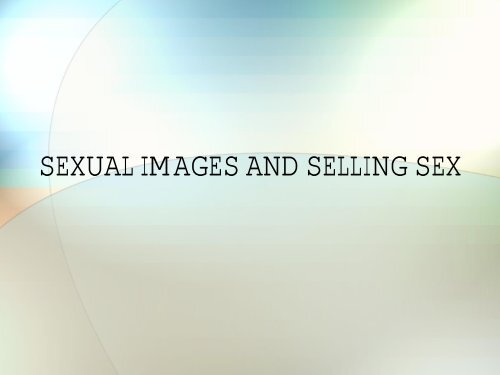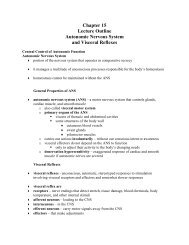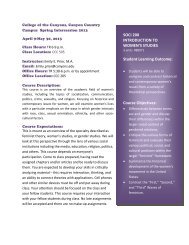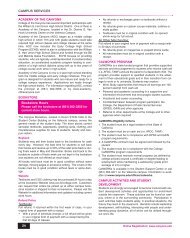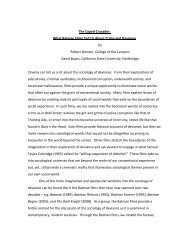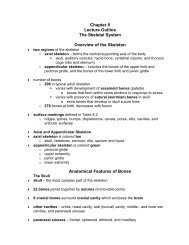SEXUAL IMAGES AND SELLING SEX
SEXUAL IMAGES AND SELLING SEX
SEXUAL IMAGES AND SELLING SEX
Create successful ePaper yourself
Turn your PDF publications into a flip-book with our unique Google optimized e-Paper software.
<strong><strong>SEX</strong>UAL</strong> <strong>IMAGES</strong> <strong>AND</strong> <strong>SELLING</strong> <strong>SEX</strong>
EROTIC REPRESENTATIONS IN HISTORY<br />
• By the dawn of the great ancient civilizations such as Egypt,<br />
people were drawing erotic images on walls or pieces of papyrus<br />
just for the sake of eroticism.<br />
• Greece is famous for the erotic art that adorned objects like bowls<br />
and urns.<br />
The Invention of Pornography<br />
• Pornography, which tends to portray sexuality for its own sake, did<br />
not emerge as a distinct category until the middle of the 18th<br />
century.<br />
• Obscenity was illegal among the Puritans because it was an<br />
offense against God.<br />
• Historians of pornography trace the modern pornographic novel<br />
back to Renaissance Italian writer Pietro Aretino (1492-1556).<br />
• The story of pornography is not just about publishing erotic<br />
material but also about the struggle between those who try to<br />
create it and those who try to stop them.<br />
• The term erotica is often used to refer to sexual<br />
representations that are not pornographic, but it means only<br />
that it is considered by a viewer or society as within the<br />
acceptable bounds of decency.
<strong><strong>SEX</strong>UAL</strong>ITY IN THE MEDIA <strong>AND</strong> THE ARTS<br />
• Over the last 25 years, representations in the mass<br />
media have become more explicitly erotic.<br />
Erotic Literature: The Power of the Press<br />
• Although the portrayal of sexuality is as old as art<br />
itself, pornography and censorship are more modern<br />
concepts.<br />
• Pornography in the modern sense began to appear<br />
when printing became sophisticated enough to allow<br />
fairly large runs of popular books, beginning in the<br />
16th century.<br />
• Due to fears that people would turn away from<br />
religious teachings, by the 17th century, the Church<br />
pressured civic governments to allow them to inspect<br />
bookstores, and soon forbidden books, including<br />
erotica, were being removed.
The power of the Press continued<br />
• It was the struggle between the illicit market<br />
in sexual art and literature and the forces of<br />
censorship that started what might be called<br />
a pornographic subculture that still thrives<br />
today.<br />
• Although modern debates about pornography<br />
tend to focus more on explicit pictures and<br />
movies, it was the erotic novel that first<br />
established pornographic production as a<br />
business in the Western world, provoking a<br />
response from religious and governmental<br />
authorities.
Television and Film:<br />
Stereotypes, Sex, and the Decency Issue<br />
• In 2003, Sex on TV: Content and Context,<br />
the largest study ever of sexual content on<br />
television was published by the Henry J.<br />
Kaiser Family Foundation.<br />
• Sixty-four percent of all shows included some<br />
sexual content.<br />
• Thirty-three percent were found to include<br />
sexual behaviors.<br />
• Fourteen percent included sexual intercourse<br />
• It is estimated that 15% of shows today with<br />
sexual contact have references to safer sex.
Advertising: Sex Sells and Sells<br />
• In his groundbreaking book Gender<br />
Advertisements, Erving Goffman (1976) used<br />
hundreds of pictures from print advertising to<br />
show how men and women are positioned or<br />
displayed to evoke sexual tension, power<br />
relations, or seduction.<br />
• Research from the 80s and 90s suggested that<br />
gender biases existed in advertising.<br />
Advertising and Portrayals of Sexuality<br />
• a. Sexually explicit advertising has become<br />
more common in the last 30 years.<br />
• b. Some researchers claim that<br />
advertisements have tried to use subliminal<br />
sexuality in advertisements.
PORNOGRAPHY <strong>AND</strong> THE PUBLIC’S RESPONSE<br />
• The debate over pornography is particularly active today<br />
because pornography has become so widely available.<br />
Court Decisions<br />
• The legal definition of obscenity dates back to the 1868 case<br />
of Regina v. Hicklin in England where the court defined<br />
obscenity as material that tended “to deprave and corrupt<br />
those whose minds are open to such immoral influences.”<br />
• The Hicklin decision permitted the confiscation of obscene<br />
materials due only to their sexual content, which remained the<br />
American standard until the 1930s.<br />
• Court cases in the U.S. have established the 3-part definition<br />
of obscenity.<br />
• It must appeal to the prurient interest<br />
• It must offend contemporary community standards<br />
• It must lack serious literary, artistic, political, or scientific value<br />
• Obscenity laws have been used in the 20th century to control<br />
many fiction and nonfiction books.
Presidential Commissions<br />
• In 1967, President Lyndon Johnson set up a<br />
commission to study “a matter of national<br />
concern”: the impact of pornography on<br />
American society.<br />
• The commission studied four areas:<br />
pornography’s effects, trafficking and distribution<br />
of pornography, legal issues, and positive<br />
approaches to cope with pornography.<br />
• The commission concluded that no reliable<br />
evidence was found to support the idea that<br />
exposure to elicit sexual materials is related to<br />
the development of delinquent or criminal sexual<br />
behavior among youth or adults, so adults should<br />
be able to decide for themselves what they will or<br />
will not read.
More Government Research<br />
• The 1986 Attorney General’s commission<br />
on pornography (the Meese Commission)<br />
• In 1985 President Ronald Reagan set out<br />
to overturn the 1970 ruling on<br />
pornography.<br />
• Those who did not support the<br />
Commission’s positions were treated with<br />
hostility.<br />
• The Meese Commission came to the<br />
opposite conclusion of the 1970 ruling,<br />
dividing pornography into 4 categories:<br />
violent, degrading,<br />
nonviolent/nondegrading, and nudity.<br />
• The reaction was strong and mixed.
The Pornography Debates:<br />
Free Speech and Censorship<br />
• The religious-conservative opposition to<br />
pornography is based on a belief that people have<br />
an inherent human desire to sin and that<br />
pornography reinforces that tendency and so<br />
undermines the family, traditional authority, and<br />
the moral fabric of society.<br />
• The issue of pornography has been divisive among<br />
feminist scholars, splitting them into two general<br />
schools.<br />
• The antipornography feminists, led by Catharine<br />
MacKinnon and Andrea Dworkin, see pornography as an<br />
assault on women that silences them, reinforces male<br />
dominance, and indirectly encourages sexual and<br />
physical abuse against women.<br />
• The other perspective includes group such as the<br />
Feminist Anticensorship Taskforce and argues that<br />
censorship of sexual materials will eventually be used to<br />
censor such things as feminist writing and gay erotica<br />
and would endanger women’s rights and freedoms of<br />
expression.
Anti-pornography Arguments<br />
• MacKinnon argues that pornography is about power and<br />
cannot be separated from the long history of male domination<br />
of women and that it reinforces women’s second-class<br />
status.<br />
• Andrea Dworkin sees pornography as a central aspect of<br />
male power, which she sees as a long-term strategy to<br />
elevate men to a superior position in society by forcing even<br />
strong women to feign weakness and dependency.<br />
Anticensorship Arguments<br />
• Many critics argue that a restriction against pornography<br />
cannot be separated from a restriction against writing or<br />
pictures that show other oppressed minorities in subordinate<br />
positions.<br />
• Once sexually explicit portrayals are suppressed,<br />
anticensorship advocates argue, so are the portrayals that try<br />
to challenge sexual stereotypes.
Studies on Pornography and Harm<br />
• Societywide Studies<br />
• Correlations that sex offenders have large<br />
amounts of pornography have been used since<br />
the early 19th century to justify attitudes toward<br />
pornography.<br />
• Researchers have found higher rates of rape in<br />
states with the highest circulation of sex<br />
magazines, yet in countries where pornography is<br />
common and/or unregulated there are low rates<br />
of rape relative to the United States.<br />
• One longitudinal research study could find no<br />
increase in rape relative to other crimes in four<br />
countries as the availability of pornography<br />
increased dramatically.
Individual Studies<br />
• While little evidence indicates that<br />
nonviolent, sexually explicit films provoke<br />
antifemale reactions in men, many studies<br />
have shown that violent or degrading<br />
pornography does influence attitudes.<br />
• Other studies show that men’s aggression<br />
tends to increase after seeing any violent<br />
movie, even if it’s not sexual.<br />
What is Harm?<br />
• a. Voices of women are silent in<br />
pornography studies.<br />
• Questions of harm focus on whether<br />
pornography induces sexual violence in<br />
men.
Online Pornography<br />
• Industry is growing and worth approximately $1<br />
billion in 2003.<br />
• Estimated that one-third of all Internet users visit<br />
sexual websites.<br />
• Viewers can be recreational users (enter sites<br />
due to curiosity) at-risk users (those increasingly<br />
drawn to increase usage) compulsive users (who<br />
spend over 11 hours per week engaging in online<br />
sexual activities.<br />
What the Public Thinks About Pornography<br />
• The majority of the general public wants to ban<br />
violent pornography and feels that pornography<br />
can lead to a loss of respect for women, acts of<br />
violence, and rape.<br />
• Research suggests that even people who felt that<br />
pornography had negative effects on others were<br />
opposed to regulating it.
Discussion/Group Questions<br />
1. Have you ever bought a product<br />
because the advertising sold you?<br />
Was sex used to sell it? What made<br />
you want to buy the product?<br />
2. Do you think using pornography is<br />
helpful or harmful in society (at an<br />
adult level)? Why? Why Not?


